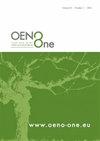Isotopic comparison and correlation of δ13C between bulk wood and cellulose of Vitis vinifera L.
IF 2.2
3区 农林科学
Q3 FOOD SCIENCE & TECHNOLOGY
引用次数: 1
Abstract
This study aims to compare the δ13C isotopic signal between bulk wood and α-cellulose in wood samples from the main trunk of Vitis vinifera L. to verify whether α-cellulose extraction is necessary for ecophysiological studies in this species. A pool of samples from different cultivars and provenances was analysed. The wood samples were obtained from cross sections of the main trunk of the plants, from where the annual growth rings were anatomically recognised, dated to the year of formation, and then separated. Each ring comprised both early- and latewood portions. For each sample, a part was saved as bulk wood and another part was destined for α-cellulose extraction. The δ13C isotopic signal in both types of samples was performed on a Vario Micro Cube elemental analyser coupled to a continuous flow mode to an isotope ratio mass spectrometer. A least squares regression was used to verify the correlation between the two variables. The results showed that the correlation coefficient of the isotopic signal for both types of samples was 0.86, and the slope of the regression line was not significantly different from one. Those results indicated that it is acceptable to use bulk wood instead of α-cellulose for δ13C isotopic studies in Vitis vinifera. This study is the first to compare isotopic δ13C signals between bulk wood and α-cellulose in grapevines. Therefore, this study constitutes a starting point to explore dendrochemical techniques based on the analysis of the δ13C content in Vitis vinifera wood, with the aim of deepening the ecophysiological knowledge of the grapevine in relation to water economy strategies and the links with climate variability and change.葡萄散装木材与纤维素的δ13C同位素比较及相关性研究。
本研究旨在比较葡萄主干木材样品中散装木材和α-纤维素的δ13C同位素信号,以验证α-纤维素是否需要提取用于该物种的生态生理研究。对来自不同品种和种源的样品池进行了分析。木材样本是从植物主干的横截面上获得的,从解剖学上识别出年轮,确定其形成的年份,然后分离。每个环都包括早期和晚期的部分。对于每个样品,一部分作为散装木材保存,另一部分用于α-纤维素提取。两种样品的δ13C同位素信号在Vario Micro Cube元素分析仪上进行,该分析仪与同位素比值质谱仪耦合为连续流模式。使用最小二乘回归来验证两个变量之间的相关性。结果表明,两种样品的同位素信号相关系数均为0.86,回归线斜率与1无显著差异。这些结果表明,用散装木材代替α-纤维素进行葡萄δ13C同位素研究是可以接受的。本研究首次比较了葡萄藤散装木材和α-纤维素的同位素δ13C信号。因此,本研究是在葡萄木材δ13C含量分析的基础上探索树木化学技术的起点,旨在加深葡萄生态生理与水经济策略及其与气候变率和变化的联系的认识。
本文章由计算机程序翻译,如有差异,请以英文原文为准。
求助全文
约1分钟内获得全文
求助全文
来源期刊

OENO One
Agricultural and Biological Sciences-Food Science
CiteScore
4.40
自引率
13.80%
发文量
85
审稿时长
13 weeks
期刊介绍:
OENO One is a peer-reviewed journal that publishes original research, reviews, mini-reviews, short communications, perspectives and spotlights in the areas of viticulture, grapevine physiology, genomics and genetics, oenology, winemaking technology and processes, wine chemistry and quality, analytical chemistry, microbiology, sensory and consumer sciences, safety and health. OENO One belongs to the International Viticulture and Enology Society - IVES, an academic association dedicated to viticulture and enology.
 求助内容:
求助内容: 应助结果提醒方式:
应助结果提醒方式:


